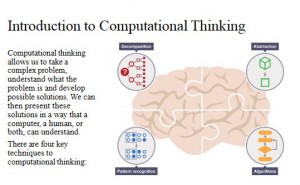


Subject:
Digital technologies
Year level:
Year 6
Strand:
Digital implementation
Sub strand:
Investigating and defining (Define a problem, and a set of sequenced steps, with users making decisions to create a solution for a given task)
Link to the resource:
https://www.tes.com/teaching-resource/computational-thinking-for-gcse-computer-science-11111367
* You may need a TES account to access the resource
Cross-curriculum priorities and general capabilities:
Links to other learning areas:
- English
- Maths
- Science
- Health
A classroom activity using this resource:
This PowerPoint includes several interactive activities that the teacher could lead and students could work through as a whole class. Alternatively students could be in groups and each group could have their own device where they are able to access the computational thinking PowerPoint. Students will need to work together to read the problem-solving activities which all involve computational thinking. From there students need to then work out solutions using branching (decisions). To conclude the lesson the teacher will gather students together and ask them for their responses to each activity. To assess the task the teacher should also collect students’ notes and answers that they have written down or typed up on a separate document. This activity would run for a full 45-50 minute lesson. The teacher needs to provide each group with their own set of articulate cards, which has also been made available through the link to the resource provided above.
How to use this resource:
This resource is very simple to use. It is presented like a basic PowerPoint that includes large tasks for students to complete. Embedded in the PowerPoint are some links that involve further explanation of a concept through a short YouTube clip. As stated above this resource comes with a set of articulate cards which students will need for one of the activities.
-Isabelle Pitchen 10321170




